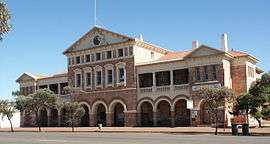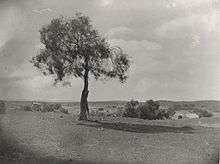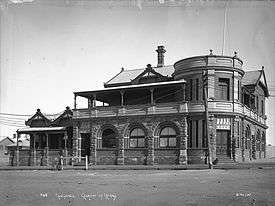Coolgardie, Western Australia
| Coolgardie Western Australia | |
|---|---|
 Coolgardie Warden's Court | |
 Coolgardie | |
| Coordinates | 30°57′11″S 121°09′50″E / 30.953°S 121.164°ECoordinates: 30°57′11″S 121°09′50″E / 30.953°S 121.164°E |
| Population | 954 (2011 census)[1] |
| Established | 1892 |
| Postcode(s) | 6429 |
| Location |
|
| LGA(s) | Shire of Coolgardie |
| State electorate(s) | Eyre |
| Federal Division(s) | O'Connor |
Coolgardie is a small town in Western Australia, 558 kilometres (347 mi) east of the state capital, Perth. It has a population of approximately 1,000 people.[1]
Although Coolgardie is now known to most Western Australians as a tourist town and a mining ghost town, it was once the third largest town in Western Australia (after Perth and Fremantle). At this time, mining of alluvial gold was a major industry and supplied the flagging economy with new hope. Many miners suffered under the harsh conditions, but for a few, their finds made the hard work worthwhile. Most men, however, left poorer than they had started off, with their hopes dashed.
History


The town was founded in 1892, when gold was discovered in the area.[4] Australia had seen several major gold rushes over the previous three decades, mostly centred on the east coast, but these had mostly been exhausted by the 1890s. With the discovery of a new goldfield, an entire new gold rush began, with thousands flocking to the area. By 1898, Coolgardie was the third largest town in the colony, with an estimated population of 5,008 (3,151 men and 1,857 women).[5] At its peak, 700 mining companies based in Coolgardie were registered with the London Stock Exchange. The town also supported a wide variety of businesses and services, including the railway connection between Perth and Kalgoorlie,[6] a swimming pool (first public baths in the state), many hotels and several newspapers.
The value of Coolgardie to the colony in the late 1890s was so very significant that it was used as leverage to force Western Australia to join the Australian federation - Britain and the eastern colonies threatened to create a new state to be named Auralia around Coolgardie and other regional goldfields, such as Kalgoorlie, if the government in Perth did not agree to hold a referendum on federation. The Western Australian government reluctantly complied and a referendum was held just in time to become a founding state in the new federation. When federation did occur in 1901, Coolgardie was the centre of a federal electorate, the Division of Coolgardie. Soon after in November 1901, Alf Morgans from the state electorate of Coolgardie briefly became Premier of Western Australia. Albert Thomas, also of Coolgardie, was elected the first Member of Dundas, an electoral division south of Coolgardie.
However, the gold began to decrease in the early 1900s, and by World War I, the town was in serious decline. The federal electorate was abolished in 1913 due to the diminished population, as many of its residents left for other towns where the gold was still plentiful, and it soon ceased to be a municipality. The situation remained unchanged throughout the century, as its population slipped to around 200 and it became a virtual ghost town. An example of this decline is that, in March 1896, Coolgardie's main street was lit by an electric light, but by April 1924, the same street was lit by four hurricane lamps.
Despite this, many of the buildings from the town's peak were retained, which in recent years has helped start a small revival in the town's fortunes. The development of a tourist industry has once again created some employment in the town, resulting in a small increase in population. Coolgardie appears to be no longer in danger of dying.
Gallery
 Prospector riding "Misery", a famous camel that travelled a record 600 mi without water, 1895[7]
Prospector riding "Misery", a famous camel that travelled a record 600 mi without water, 1895[7] Aboriginals participate in ceremony to mark the opening of the Coolgardie Railway Line, 1896
Aboriginals participate in ceremony to mark the opening of the Coolgardie Railway Line, 1896 Miners burn effigy of prospector who lied about gold discovery near Coolgardie, 1897
Miners burn effigy of prospector who lied about gold discovery near Coolgardie, 1897 Coolgardie Chamber of Mines, ca. 1900
Coolgardie Chamber of Mines, ca. 1900
Muslim Afghan cameleers

When the Coolgardie gold rush occurred in 1894, the Afghan cameleers (so-called, although they did not originate in Afghanistan) were quick to move in. The goldfields could not have continued without the food and water they transported. In March that year, a caravan of six Afghans, forty-seven camels and eleven calves, set out across the desert from Marree to the goldfield. It arrived in July with the camels, carrying between 135 and 270 kilograms each, in good condition. Another fifty-eight camels for Coolgardie arrived by ship in Albany in September.[8]
By 1898 there were 300 members of the Muslim community in Coolgardie and 80 on average attended Friday prayer. Coolgardie held the main Muslim community in the colony at that time. There was not one Muslim woman amongst them, no marriages were performed and no burials, reflecting a relatively young and transient population.
Similar to the other structures, simple mud and tin-roofed mosques were initially constructed in the town. All of the Afghan Muslim population eventually relocated from Coolgardie generally to Perth, the new capital of Western Australia. Racism was very common towards the Afghan cameleers, there were reports of unsolved murders and torture of Afghan owned animals.
Transport
Great Eastern Highway (National Highway 94) runs through the town as Bayley Street. Just to the town's east, Highway 94 turns south onto Coolgardie-Esperance Highway, which heads towards Norseman, the starting point of the route east across the Nullarbor Plain.
Originally the narrow gauge railway to Kalgoorlie, the Eastern Goldfields Railway passed through Coolgardie, until 1968, when the new standard gauge line was built to the north on a new route.
The Transwa Prospector train stops 14 km north of the town at Bonnie Vale. There is a very limited public bus service to the town on the Kalgoorlie to Perth route, although school bus services are more frequent.
Mining fields
In the 1890s there were four mining fields gazetted with Coolgardie as reference point:
- Coolgardie Gold Field (1894)
- East Coolgardie Gold Field (1894). In 1902, this was the richest gold field in Western Australia.[9]
- North Coolgardie Gold Field (1895)
- North East Coolgardie Gold Field (1896)
Despite the changes to the Kalgoorlie region, Coolgardie still has a Mining Registrar.
See also
- Varischetti mine rescue at nearby Bonnie Vale in 1907
- Burbanks Gold Mine
- Coolgardie Gold Mine
- Coolgardie safe.
References
- 1 2 Australian Bureau of Statistics (31 October 2012). "Coolgardie (L) (Urban Centre/Locality)". 2011 Census QuickStats. Retrieved 2012-10-30.

- ↑ "Our biggest nugget arrives in time for Gold Week". The Courier. Ballarat, Vic. 15 April 2004. Retrieved 2 September 2016.
- ↑ "Class B objects refused an export permit - Prior to 2013". Movable Cultural Heritage Prohibited Exports Register. Canberra, ACT: Commonwealth of Australia Department of Communications and the Arts. Retrieved 3 September 2016.
- ↑ Ford, Lyall (2001). Poorhouse to Paradise: The Adventures of a Pioneering Family in a North Queensland Town. Freshwater, Queensland: Taipan Press. p. 14. ISBN 0646332546.
- ↑ "Population of Western Australia", Western Mail (Perth, WA : 1885 - 1954), 22 April 1898, p. 23
- ↑ Morris, Bernie & Milne, Rod (2008) Coolgardie's Railway Days Australian Railway History, June; July, 2008 pp183-196; 219-234
- ↑ Reid, Arthur. Those Were the Days. Perth: Hesperian Press, 1986. ISBN 0-85905-101-3, p. 97
- ↑ A History of Islam in Australia accessed: 27 May 2010
- ↑ Howell, Arthur (April 1902). "The Western Australian Gold Fields". Mines and Minerals. 22: 395. Retrieved 2011-04-26.
External links
| Wikimedia Commons has media related to Coolgardie, Western Australia. |
_(Kalgoorlie_region%2C_Western_Australia)_2_(16992820417).jpg)